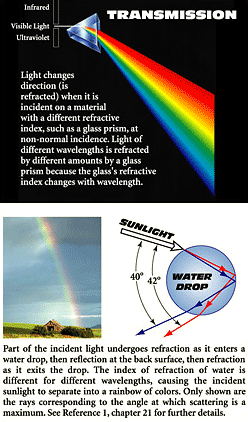Dispersion

If you’ve ever seen a rainbow or a prism split what appears to be white light into its rainbow of color components, you’ve seen chromatic dispersion. (White light comes from a source that emits many wavelenths of EM Rad. Sunlight is white light.) In a dispersive material, different wavelengths travel at different speeds, which is the same as saying that each wavelength of EM Rad has a different refractive index in the material! The practical result of this, as predicted by Fermat’s Principle, is that no one path is the shortest for all wavelengths in most optical systems. Different wavelengths of EM Rad always follows their own fastest route though an optical system.
This has several consequences. One is that the different color components of white light will possess different angles of refraction when the white light is incident, with a non-zero angle of incidence, on an interface between two media. Prisms and rain drops both create rainbows because of this effect.
Chromatic dispersion is especially important to researchers who are designing optical equipment like cameras, optical microscopes, and telescopes. When a lens system is not carefully designed, the system will focus different colors of light at different spots – and this doesn’t give a very good image! By planning the system carefully and using a combination of lenses made out of different materials with different indices of refraction, these chromatic aberrations can be greatly minimized.
Lens systems in sensitive equipment must be carefully designed to reduce the magnitude of chromatic dispersion and other aberrations (more on aberrations later). One way to correct for chromatic aberrations is to form a compound lens called an achromat. This doublet is made up of a positive lens that is made from crown glass, and a negative lens that is made from flint glass. Crown glass has moderate dispersion and flint glass has higher dispersion. The positive crown glass is made into a positive lens, and the flint glass is made into a negative lens. The powers of two lenses in contact add: P = P1 + P2 so it is possible for the doublet to have positive power if the power of the positive lens is greater than the power of the negative lens. The different dispersions of the two glasses, combined with a careful adjustment of the curvatures of the two lenses can result in a compound lens that is corrected for chromatic aberrations.
The effect of chromatic dispersion is also important to people who send short pulses, which are made up of many different wavelengths, through optical waveguides, like optical fiber. Short pulses of EM Rad are used as a way of encoding data, like voices during a telephone call and the information on this website, so that the data can be sent from one place to another. As the pulse travels in the waveguide, some wavelengths of light travel faster than others. As the pulses travel down the waveguide, they increase in width and overlap with one another. If they spread too much, it is difficult to tell where one pulse begins and the other ends, and this results in information being lost. Researchers who work in the Communications and Fiber Optics fields of optics are developing devices to combat the effects of dispersion. (Visit the Optoelectronics, Communications, and Fiber Optics branch to learn more.)









